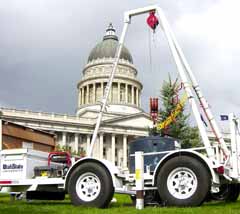Students make earth shaking progress
Earthquakes in Utah are not only caused by fault lines. Some may be a result of some heavy engineering experiments.
The civil and environmental engineering department is working on two projects of particular interest right now, among others.
James Bay, assistant professor of the civil and environmental engineering department at Utah State University, is working on one of the projects called Shallow Shear Wave Velocity Profiling of Poorly Characterized Earthquake Site-response Units in Urban Salt Lake Valley (or SSWVPOPCESRUIUSLV for short). It is a one-year project that was started on Jan. 1 and is being funded by the U.S. Geological Survey.
Bay said he is studying soil conditions in the Salt Lake Valley to see how strong the ground will move in the valley if an earthquake occurs, and also to see how an earthquake might move through different soil conditions. This will help his group see where the safest places are to build and to see how strong buildings need to be in certain areas to withstand potential earthquakes.
“Utah has few measurements of soil beneath their sites, and that is something we are working on,” he said.
Bay also said his group needs to know how fast the earthquake waves will move through the soil to see how strong ground shaking from an earthquake will be. To measure that, they generate little earthquakes. The group uses a trailer with a 400-pound weight they drop. When it hits the ground it generates waves. They set out sensors to detect the waves and determine how fast they travel through the ground.
The strength of the shaking in earthquakes is controlled by the size of an earthquake, how close the site is to the fault and the soil conditions beneath the site, Bay said. Waves move faster through rock than softer material. Buildings built on hills and bedrock withstand earthquakes better than buildings built in valleys and on soft soil.
Jeff Gilbert, a graduate student and research assistant at USU, said he will be involved in collecting data for the project. He also said he will be the one to drop the weight.
“The most interesting part of this project is dealing with the safety of all the people in the Salt Lake Valley and doing something that isn’t very well-studied,” Gilbert said. “This project will help us understand the effects of earthquakes in the Salt Lake Valley and at Utah State.”
Another project the civil engineering department at USU is working on is called An Integrated Transportation Network Reliability Analysis Framework. It is being conducted by Anthony Chen, assistant professor of civil and environmental engineering. The National Science Foundation awarded him a $375,000 grant for it.
“I was pretty surprised when I got this award,” he said. “The College of Engineering at USU has never received one of these before and I got it on my first attempt.”
The award is quite competitive, Chen said and applies to the whole country.
“I want to encourage the new faculty here to try for grants,” he said. “People think that USU is not competitive with MIT or Berkeley but they can’t think that way.”
Chen said his project involves working on making the roadways safer, more efficient, and more reliable. He is working on a model for students to use for scenario testing so they can come up with strategies themselves and test if they are effective. He is also working on short-term daily operations, such as coming up with strategies to synchronize the timing of lights on Main Street and on long-term planning for the future, like building roadways.
“There will be growth, and the land will change. We have to plan to accommodate that change and growth,” Chen said.
He said most of the money from the grant will be spent on encouraging undergraduate students to attend graduate school. He also said one of the biggest criticisms of USU is that it doesn’t produce enough graduate students. Before he came to USU, there were not many graduate students in the transportation program, but now there are 11 students, seven of which are working on their doctorate. He also said the grant money will be spent on building up the transportation program.
“I want to raise the recognition of USU in the national standing. We have a lot of research money but not a lot of Ph.D. students,” Chen said. “Hopefully, my success will open doors to other junior faculties.”
–erina@cc.usu.edu

The civil and environmental engineering department demonstrate their earthquake simulator at the Utah State Capitol Building last year (Engineering Department photo)

